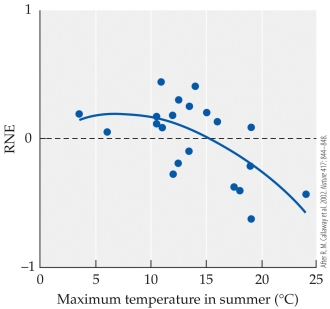Question 21
(Multiple Choice)
Refer to the figure.
 The figure shows the RNE (relative neighbor effect) correlated to summer temperatures in alpine plants. Higher summer temperatures indicate communities at lower elevations, where plants are less stressed. The RNE is one measurement of the degree of mutualism in a community-the higher the RNE, the stronger the mutualistic interaction. Based on the data in this figure, which conclusion can be drawn about the importance of mutualism in this community?
The figure shows the RNE (relative neighbor effect) correlated to summer temperatures in alpine plants. Higher summer temperatures indicate communities at lower elevations, where plants are less stressed. The RNE is one measurement of the degree of mutualism in a community-the higher the RNE, the stronger the mutualistic interaction. Based on the data in this figure, which conclusion can be drawn about the importance of mutualism in this community?
A) Mutualism is relatively unimportant among alpine plants.
B) Mutualism becomes stronger under less stressful conditions.
C) Mutualism becomes stronger under more stressful conditions.
D) Mutualism becomes stronger at lower temperatures, but stress is not a factor.
Answer